- Published 27 Feb 2024
- Last Modified 6 Mar 2024
- 11 min
A Complete Guide to Fibre Optic Cables

What are Fibre Optic Cables?
Fibre optic cable is an advanced type of network cable. It offers significantly improved performance in terms of both bandwidth and data carrying than traditional metal conductor alternatives.
What is Optical Fibre?
Fiber or fibre optic technology is an effective cabled-based communication system. It is reliable, versatile, and widely used in many applications and industries.
Optical fibre cabling is used to transfer information via pulses of light, which pass along one or more transparent plastic or glass pipes. In some cases, this can be more than several hundred pipes. Each of these strands is little wider than an average hair and is normally surrounded by a further layer of cladding which is also in plastic or glass but constructed at a different density to the main inner strand.
A sheath made up of several layers of insulated casing is also wrapped around the cladded fibres. This usually comprises of a protective wrapper, known as a buffer tube, followed by a final outer jacket designed to protect the entire multi-stranded cable.
Optical Fibre Cable Uses
Optic cables are commonly found in a variety of applications such as the internet and broadband, phone lines, networking, and telecommunications. Additional fibre optic cable uses in the home and workplace include lighting and interior decor.
Optical fibre cable can save space compared to bulkier traditional cabling. This ability has also made it popular for many safety and lighting features in vehicles. Optical fibre technologies are widely used in many other demanding professional fields too, including in medical applications, for detailed mechanical inspections, and as sensors for monitoring and controlling the flow of various sorts of electrical currents, sounds and chemicals.
Optical Fibre Internet and Networking
Fibre optic internet cable is increasingly popular. This is due to the higher speeds and bandwidth it can provide compared to standard ethernet or Wi-Fi signals delivered via coaxial or even copper wire from street-level exchanges. This means that fibre networking is a far better choice where high speeds are advantageous or for particularly intensive data transfer needs. Much of this is also true for fibre optic phone lines.
Fibre optic bandwidth is usually significantly higher than a typical ethernet connection. Fibre is also safe to use in high-voltage locations, and in areas where flammable gases or other harsh chemicals or weather conditions are likely to be a factor. This can be another important factor in choosing fibre optic cables for broadband delivery and telecoms as opposed to standard ethernet.
Fibre Optic Cables for Lighting
LED lighting is also a common application of fibre optic technology in domestic and commercial environments. Fibre optics can transmit data in a clean and versatile manner across a wide spectrum of colours and patterns. This means that it is widely used in decorative lighting applications, accent lights, and feature lamps.
Far less electricity is also used by fibre optic LED lighting compared to standard bulb options, which makes it both environmentally friendly and economical. You can buy fibre optic lighting cables that are safe to use in a wide variety of applications and environments. They do not carry electrical current and are largely resistant to general wear, damage and degradation.
How Do Fibre Optics Work?
In understanding how optical fibres work and how data is sent through optic cables, it is important to note that there are multiple components involved in the construction of optical fibre. All are required to ensure successful fibre optic installation. The glass strands themselves are absolutely central to the system, but there is also a number of other key parts that play a role in effective data transfer along optical fibres.
Firstly, a source of light is needed to transmit information pulses along the transparent strands of plastic or glass tubing strands at the cable's core. This is usually created either by a tiny laser or by an LED source, which receives an input signal coming from the optical transmitter circuitry and converts it to a light pulse before bouncing it along the fibre cores.
Secondly, the glass fibres themselves must be surrounded by an additional glass or plastic cladding layer. This will have a different refractive index for light passing through it than the core strands. These refractive differences between the cladding and the glass fibres it surrounds are what allow the incoming light pulses to be bent at particular angles as they travel the length of the cable.
The rays of light remain inside the transparent fibre cable parts as a result of the reflective internal properties. They move along the cable run's full length, bouncing in a zig-zag pattern to navigate bends. At various points, they might be converted into electrical signals before turning back into light pulses again. Additional components called repeaters are used for this and it is done to maintain high signal strength for longer cable runs.
After travelling at approximately 70% of the speed of light for the majority of the journey, the light signals can eventually be interpreted as communications or data signals once they arrive at their intended destination. Receiving equipment is used to convert them to the desired output.
Optical Fibre Diagram
This handy diagram clearly illustrates the different components that make up a fibre optic cable. The fibre itself is comprised of a core and cladding.
As explained below, these have different refractive indexes to aid the travel of light along the cable. A protective coating, jacket or strength members will then encompass the core and cladding. This is then surrounded by an armoured outer jacket which forms the visible part of the cable. This may be IP-rated for water-blocking purposes.
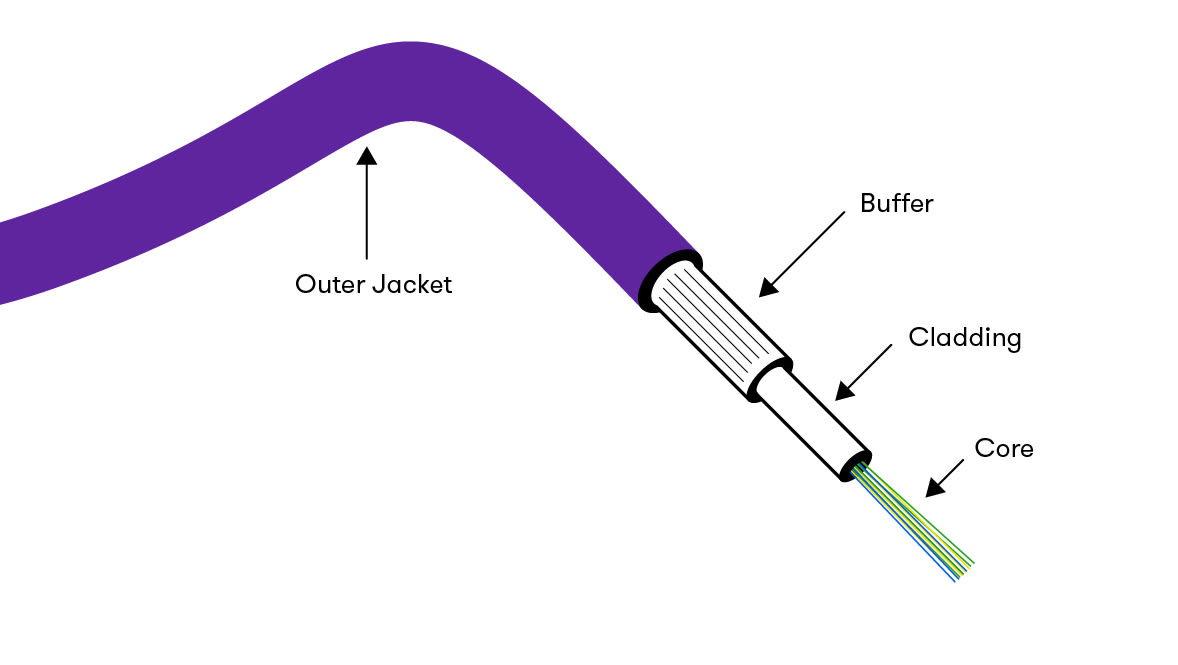
How Does Fibre Optic Cable Work?
This second optical fibre diagram shows the basic principle of the technology and how it works.
Light enters at one end of the cable and travels through the highly refractive core, bouncing off the cladding which has a low refractive index for this exact reason. Once a beam reaches the end, it is dispersed at an approximately 60° angle and emitted to the target.
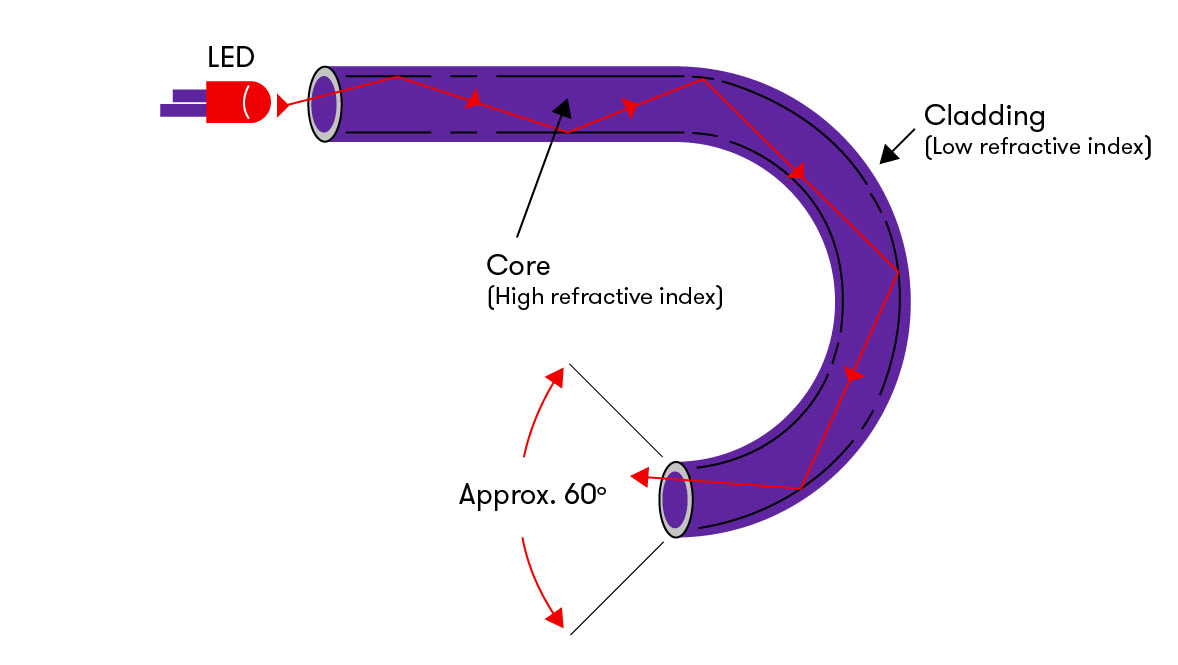
Fibre Optic Cable Specification and Characteristics
Optical fibre cabling has numerous key classifications and characteristics. These directly impact its efficiency regarding line speed, signal strength, and bandwidth.
Below is a number of factors which could influence optical cable's overall performance.
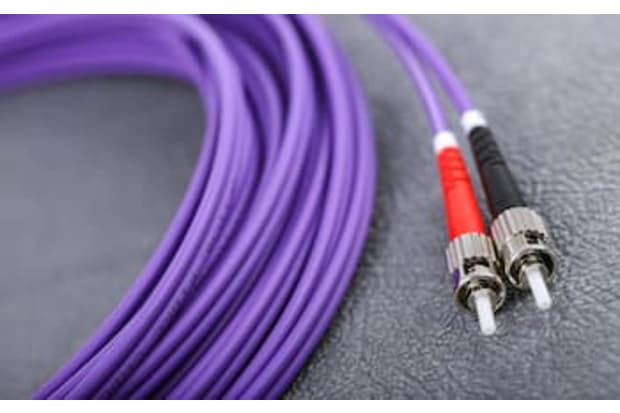
Fibre Optic Cable Transmission Speed
Fibre optic data transfer rates are usually reliant on several aspects - chiefly the cable mode. Optical fibres can be configured as either singlemode or multi mode. These arrangements are designed to deliver lower or higher standard broadband speeds (measured in Mbps) over certain defined distance ranges.
However, optical fibre speed is still extremely high regardless of whether you are using a multi-mode or single-mode cable. Fibre optic cables offer the fastest commercial-grade mode of communications data transfer and internet connectivity currently available.
Fibre Optic Bandwidth
Fibre optic bandwidth is the frequency where the magnitude of the response has decreased to half of its zero-frequency value. This refers to the power transmission frequency and amount of data able to be transferred over a set period of time.
Similarly to optical fibre speed, bandwidth is also high. This is due to the fact that data can be transmitted quickly and efficiently, using a range of frequencies without attenuation.
Fibre Optic Cable Connectors
As with all cables, connectors are required to effectively terminate fibre optic cables. Several different connector types are available and it is important to choose the right one for successful fibre optic connection. This will depend primarily on the equipment and optical fibre in use.
Some of the most common types of fibre optic cable connectors include:
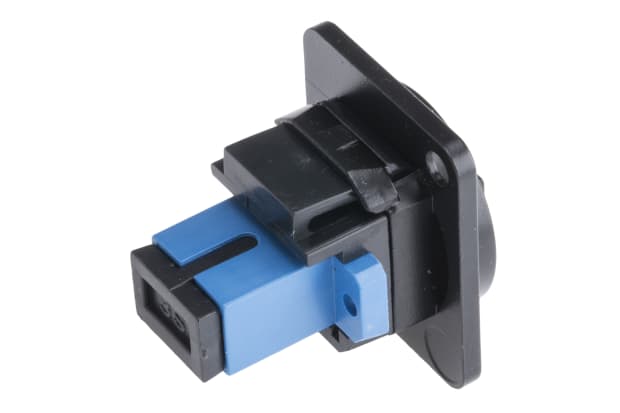
SC Connectors
SC connectors are the most widely used variation. They have a 2.5mm ferrule and utilise a straightforward pull-push motion to latch and snap onto the cable. Versatile and efficient, they are used in a wide range of environments.

LC Connectors
LC connectors are small and compact, ideal for applications where space is limited. They have a 1.25mm ferrule and are half the size of the standard SC connector.
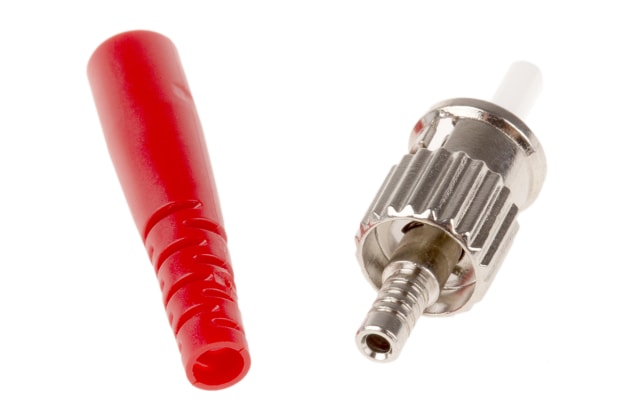
ST Connectors
Although ST connectors are still in use, they are now typically used less often than LC and SC connectors. They also have a 2.5mm ferrule but feature a secure bayonet connection.
Advantages of Fibre Optic Cable
Fibre optic cabling has several major characteristics which provide a strong advantage compared to traditional copper conductor cables.
Key advantages of optical fibres include:
- Distance - because of their low signal power loss rate, fibre optic cables are able to carry optical signals over far longer distances than older types of cabling. With the ideal combination of network setup, materials, and wavelength, some single fibre optics are effective at carrying signals over hundreds of kilometres. In comparison, standard copper cables have a limitation of 328-feet for good quality transfer distance
- Bandwidth and data transfer - copper data cables offer quite limited bandwidth as opposed to fibre optics
- Speed - fibre optic cables enjoy a significant speed advantage compared to other data transfer modes because they use light pulses as the primary information conveyance source. In this regard, fibre typically outstrips the expected performance of even high-grade copper cables such as Cat5 and Cat6
- Interference - much more protection is provided against interference and cross-talk by fibre optics than metal cables. This is because fibre does not carry a physical electrical signal
- Reliability and safety - although optical fibre cables are usually a lot lighter and thinner, they are also sturdier. This means that they can withstand far greater forces and therefore the chances of incurring breakage or damage across long runs are less likely. Fibre is not influenced by moisture, poor weather, or extreme temperatures nearly as much as copper-based wiring. Additionally, as glass fibres do not carry current, they are not fire hazards even if they are ageing or damaged
Fibre Cable Types
There are multiple fibre optic cable types, and it is important to understand the differences between each one. Each has distinct advantages and will be suited to varying environments, applications, or industries.
Some of the main fibre cable types are explored below:
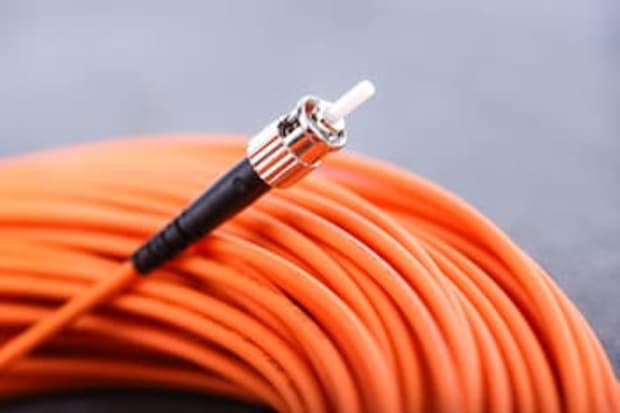
Glass Fibre Cable
In terms of bend and flex, glass optical fibre is more delicate than its plastic counterparts. This also means that it is more susceptible to damage - especially if it has to loop tightly or be moved continually over its run length. It cannot be cut, repaired, or spliced, which means that it is not suitable for applications where high levels of flexibility are needed.
Despite this, glass fibre optic cables are sturdy and durable in terms of both mechanical strength and overall resistance to chemicals, moisture, fluctuating temperatures, and extreme environments. This makes it well-suited to longer-distance applications where cables are often submerged or buried. Due to the many different fittings, adapters, and configurations available, it is also noted for its versatility.
Glass fibre is regularly used in challenging and longer-distance applications. It often costs more to purchase and install than more economical plastic variations, which also boast greater flexibility and ease of use for most non-specialised applications.
Single-Mode Cables
Single-mode and multimode optical fibres are varying cable configuration types. They deliver different potential performance levels at distance.
Single-mode fibre optic cables are comprised of one glass fibre strand with a fairly slim core diameter. Far less internal reflection is involved as light rays pass through it, therefore reducing attenuation and allowing for far higher speed data transfer over longer distances. This configuration is typically used for long-distance signal transmission.
Multimode Cables
Conversely, multimode cables feature larger cores that guide many modes simultaneously. Multimode fibre cabling significantly increases reflection. This results in higher attenuation and dispersion rates, therefore increasing bandwidth delivery over short distances. Applications needing large data volumes sent over shorter runs (such as communication data in or between a small localised area) typically utilise multimode fibre optic cabling.
Multimode fibre, also known as multi-core, is available in various specifications. Common everyday networking fibre optic cable configurations include two-core options, eight-core varieties, and even twelve-core fibre optic cable. Essentially, the bandwidth potential and the ability to cope with higher data throughput over shorter distances is determined by the number of cores the cable carries.